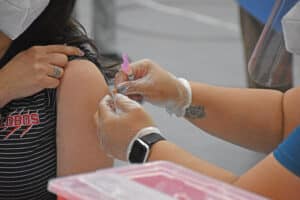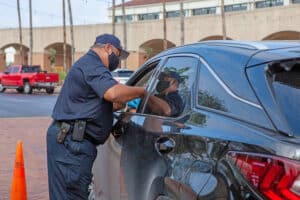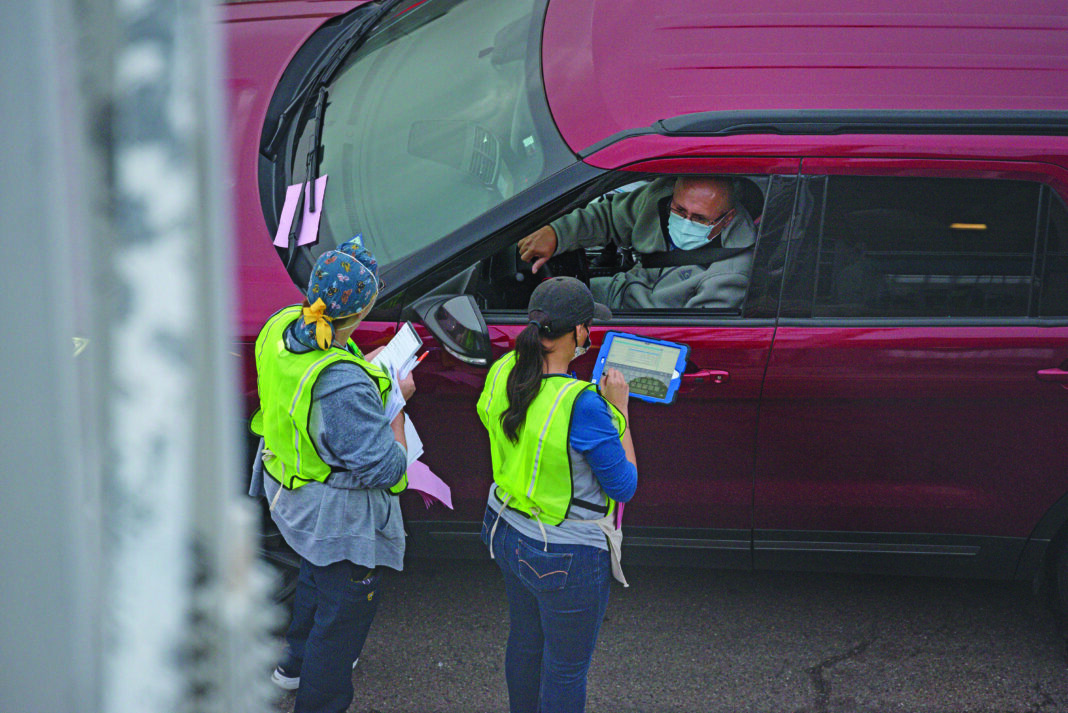State guidelines and a public charge to vaccinate all Texas residents created a backdoor allowing people who do not reside in the U.S., even temporarily, to receive the COVID-19 vaccine. But there are some who believe those doses will ultimately benefit residents, too.

(Courtesy Photo)
“The vaccine is scarce,” J.M., a Mexican businessman from Monterrey who spoke to The Monitor under the condition of anonymity, said. He cited scarcity as the motivation behind the flight his wife and mother-in-law caught to Houston earlier this month.
Vaccine rollout efforts in Mexico are lagging compared to those in the U.S.
As of the start of this week, Mexico — a country of about 126 million people — reported distributing 642,105 doses compared with 44.5 million doses distributed in the U.S., according to Centers for Disease Control and Prevention data.
J.M.’s wife found information about the Houston vaccination site online and flew with her 70 year-old mother using their travel visas, the husband said. The trip set them back a couple thousand dollars but it proved successful.
“She’s a good daughter. She didn’t want something bad happening to her mother,” J.M. said.
A total number of vaccines administered to arms of international travelers is difficult to gauge, but the interest is well-known.
“We are getting calls frequently. They’re willing to buy it,” Daniel Vela, owner of Lee’s Pharmacy, said, referring to people calling his pharmacy from Mexico offering “substantial” amount of money. “We’re not allowed to sell it, and we won’t sell it.”
The Department of State Health Services announced Monday, Jan. 4, on their website that Lee’s Pharmacy was set to receive Moderna vaccines the first week of January.
“Once it came out on the website that we were receiving an allotment, the phones started ringing and people asking to be put on the list,” he said.
By the end of that Monday, 850 people were placed on the waiting list for an allotment of 100 doses.
To get on the list, callers left their names, dates of birth, numbers of a form of valid ID, and their home addresses. The place of residence is not confirmed “because of the other data processing they have to do,” Vela said of employees taking down names for the waitlist, “it would be too cumbersome to verify each residence.”
Neither step is required by the state.

(Courtesy Photo)
“There is not a residency requirement to receive the COVID-19 vaccine,” reads an online Texas tipsheet for COVID-19 vaccine providers.
Yet, when Gov. Greg Abbott was asked Tuesday during a news conference in San Antonio if there were any protocols to ensure vaccines are used only by Texas residents, he responded, “We do.”
The governor said the state is working under CDC guidelines. He added, “U.S. vaccines are for U.S. residents. Texas vaccines are for Texas residents. It is true that you can be from Comal County and come to Bexar County and get a vaccine, and that’s just the way the process works. But you must be a Texas resident to receive a vaccine in Texas.”
“We live in different areas of the state where things need to be handled a little differently,” Cameron County Public Health Administrator Esmeralda Guajardo said.
Guajardo also chairs the Task Force of Border Health Officials, a group of health officials including Hidalgo County which discusses unique needs in the border and makes recommendations to DSHS.
Demographics are a frequent topic of discussion.
Texas has about 1.9 million unauthorized immigrants living in the state, according to the latest estimates by the U.S. Department of Homeland Security’s Office of Immigration Statistics. It comes second to California with about 2.8 million.
Public health officials’ main task is to get vaccines into the arms of local residents. In the Rio Grande Valley, that can include spring breakers, college students, winter visitors, and people who are living in the U.S. without legal status.
During Hidalgo County’s first vaccination clinic, a woman asked an employee if her Mexican visa would be accepted as a valid form of ID.
“There aren’t any specific ID requirements,” Douglas Loveday, a press officer with DSHS, said.
Counties are independently determining what forms of identification are valid.
In Cameron County, Guajardo said they mostly receive state and work IDs from healthcare workers to prove their age and occupation. If the state changes the guidelines, they’d pivot but it would be under a financial burden.
“I can guarantee you we would do that, but it would require, of course, more manpower. And that’s where it would hurt us,” Guajardo said.
Guajardo’s staff is scattered across the county and on their feet for hours scurrying from one vaccination clinic to another.
“I often joke that I had a health department to run at one point, and I still do,” she said, adding, “It’s pretty much on our penny.”
Fiscal responsibility aside, public health officials are facing an uphill battle against high hesitancy rates.
Guajardo knows increasing screening process tasks like checking residency would likely increase wait times.
“So, slowing this process when we know people are waiting, you just kind of have to pick your battles,” she said.
Smaller distribution sites, like Cameron County Commissioner David Garza’s Medicine Shoppe, could help create quicker access points, a strategy the new administration discussed last week at the Capitol.
Garza’s pharmacy is already state-approved to be a vaccine provider, but they are waiting for their first allocation.
As a pharmacy owner and local government official in South Texas, Garza is privy to the fickle hospitalization rates, multiple COVID-19 mutations, hesitancy rates, long registration wait times, and the politicization of vaccine distribution.
He’s also aware of the sporadic cases of vaccines given to people who do not reside in the U.S., like J.M.’s mother-in-law. Though his pharmacy will follow the state’s vaccine administration guidance, he believes those who unknowingly administered the vaccine into arms of people not living in the U.S. will see their acts benefit local communities.
“American taxpayer money is well-spent if we can keep our citizens here out of the hospital and out of ICUs,” Garza said.
In Mexico, residents are preparing to welcome the first shipment of the Russian COVID-19 vaccine, Sputnik V. The desperation felt by many, who like J.M. distrust Mexico’s distribution pace, could likely still lead them to see the U.S. as an option.
“It’s the struggle we make,” J.M. said. “Everything is about survival. If you were told you had the opportunity, wouldn’t you take it?”





